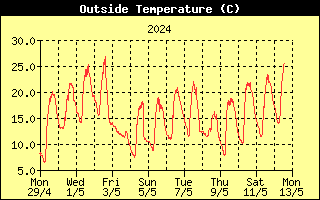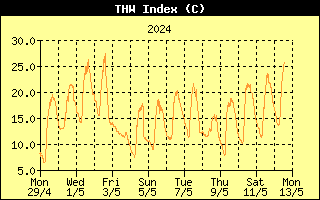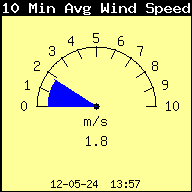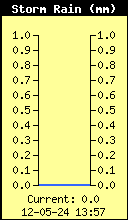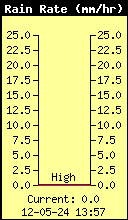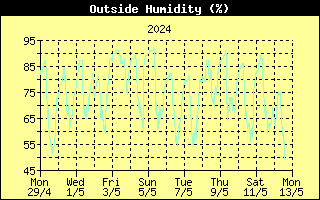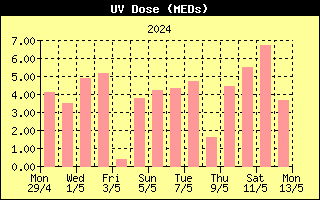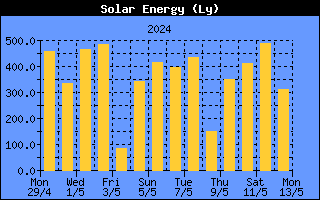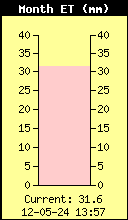Temperature
Temperature is a measurement of the average kinetic energy of the molecules in an object or system and can be measured with a thermometer or a calorimeter. It is a means of determining the internal energy contained within the system.
Wind Chill
Wind chill takes into account how the speed of the wind affects our perception of the air temperature. Our bodies warm the surrounding air molecules by transferring heat from the skin. If there’s no air movement, this insulating layer of warm air molecules stays next to the body and offers some protection from cooler air molecules. However, wind sweeps that warm air surrounding the body away. The faster the wind blows, the faster heat is carried away and the colder you feel. Wind has a warming effect at higher temperatures.
Outside Dew Point
Dew point is the temperature to which air must be cooled for saturation (100% relative humidity) to occur, providing there is no change in water content. The dew point is an important measurement used to predict the formation of dew, frost and fog. If dew point and temperature are close together in the late afternoon when the air begins to turn colder, fog is likely to occur during the night. In addition a high dew point indicates a better chance of rain, severe thunderstorms and tornados.
Outside Heat Index
The Heat Index uses the temperature and the relative humidity to determine how hot the air actually “feels”. When humidity is low, the apparent temperature will be lower than the air temperature, since perspiration evaporates rapidly to cool the body. However, when humidity is high (i.e. the air is saturated with water vapour) the apparent temperature “feels” higher than the actual air temperature, because perspiration evaporates more slowly.
THW / THSW
The THW (Temperature, Humidity, Wind) Index uses humidity, temperature and wind to calculate an apparent temperature that incorporatesthe cooling effects of wind on our perception of temperature. This index represents only humidity, temperature and wind to determine a level of thermal comfort.
Like Heat Index, the THSW (Temperature. Humidity, Sun, Wind) Index uses humidity and temperature to calculate an apparent temperature. In addition, THSW incorporates the heating effects of solar radiation and the cooling effects of wind (like wind chill) on our perception of temperature. Thus, this index indicates the level of thermal comfort including the effects of all these values.
Air Density
The density of air or atmospheric density, denoted ρ (Greek: rho), is the mass per unit volume of Earth’s atmosphere. Air density, like air pressure, decreases with increasing altitude. It also changes with variation in atmospheric pressure, temperature and humidity. At 101.325 kPa (abs) and 15 °C, air has a density of approximately 1.225 kg/m3 (or 0.0765 pounds/ft3), about 1/800 that of water according to ISA (International Standard Atmosphere)
Wind
* De windkracht volgens Beaufort wordt bepaald uit het gemiddelde van de windsnelheid over 10 minuten. Maar voor wat betreft de benaming ‘storm’ is bij het KNMI het gemiddelde over 1 uur bepalend. De windmeter die de basis vormt voor de onderstaande grafieken voldoet niet aan de officiele normen. De wind snelheid en richting worden teveel beperkt door bebouwing.
| Kracht* | Benaming | Windgemiddelde snelheid over 10 minuten (km/u) |
Windgemiddelde snelheid over 10 minuten (m/sec) |
Uitwerking boven land en bij mens |
| 0 | stil | 0-1 | 0-0,2 | rook stijgt recht of bijna recht omhoog |
| 1 | zwak | 1-5 | 0,3-1,5 | windrichting goed af te leiden uit rookpluimen |
| 2 | zwak | 6-11 | 1,6-3,3 | wind merkbaar in gezicht |
| 3 | matig | 12-19 | 3,4-5,4 | stof waait op |
| 4 | matig | 20-28 | 5,5-7,9 | haar in de war, kleding flappert |
| 5 | vrij krachtig | 29-38 | 8,0-10,7 | opwaaiend stof hinderlijk voor de ogen, gekuifde golven op meren en kanalen en vuilcontainers waaien om |
| 6 | krachtig | 39-49 | 10,8-13,8 | paraplu’s met moeite vast te houden |
| 7 | hard | 50-61 | 13,9-17,1 | lastig tegen de wind in te lopen of fietsen |
| 8 | stormachtig | 62-74 | 17,2-20,7 | voortbewegen zeer moeilijk |
| 9 | storm | 75-88 | 20,8-24,4 | schoorsteenkappen en dakpannen waaien weg, kinderen waaien om |
| 10 | zware storm | 89-102 | 24,5-28,4 | grote schade aan gebouwen, volwassenen waaien om |
| 11 | zeer zware storm | 103-117 | 28,5-32,6 | enorme schade aan bossen |
| 12 | orkaan | >117 | >32,6 | verwoestingen |
Barometric Pressure
The weight of the air that makes up our atmosphere exerts a pressure on the surface of the earth. This pressure is known as atmospheric pressure. Generally, the more air above an area, the higher the atmospheric pressure. This in turn means that atmospheric pressure changes with altitude. For example, atmospheric pressure is greater at sea level than on a mountaintop. To compensate for this difference and facilitate comparison between locations with different altitudes, atmospheric pressure is generally adjusted to the equivalent sea level pressure. This adjusted pressure is known as barometric pressure.
Barometric pressure also changes with local weather conditions, making barometric pressure an extremely important and useful weather forecasting tool. High pressure zones are generally associated with fair weather while low pressure zones are generally associated with poor weather. For forecasting purposes however the absolute barometric pressure value is generally less important than the change in barometric pressure. In general, rising pressure indicates improving weather conditions while falling pressure indicates deteriorating weather conditions.
Rain
Outside Humidity
UV
The UV Index measures the intensity of UV. It was first defined by Environment Canada and since has been adopted by the World Meteorological Organisation. UV Index uses a scale of 0 to 16 to rate the current intensity of UV. The UV value logged by WeatherLink is the average UV measured during the archive interval.
Solar Radiation
Solar radiation is a measure of the intensity of the sun’s radiation reaching a horizontal surface. This irradiance includes both the direct component from the sun and the reflected component from the rest of the sky. The solar radiation readinggives a measure of the amount of solar radiation hitting the solar radiation sensor at any given time, expressed in Watts per square meter (W/m²). The value logged by WeatherLink is the average solar radiation measured over the archive interval.
ET
Effectively, ET is the opposite of rainfall, and it is expressed in the same units of measure (millimetres). The Weather Envoy uses air temperature, relative humidity, average wind speed, and solar radiation data to estimateET, which is calculated once per hour on the hour.


